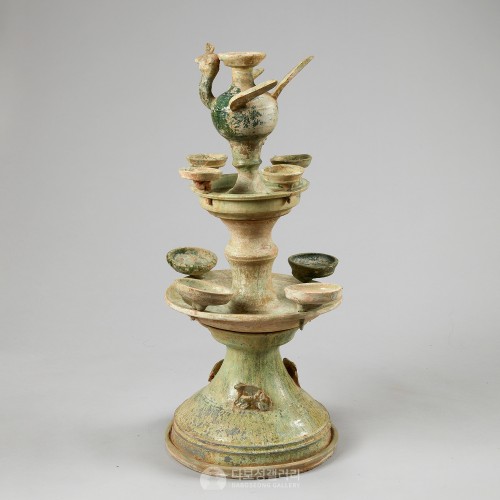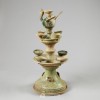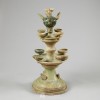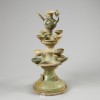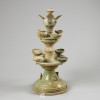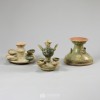본문
한나라 시기(BC206-AD220) 제작된 것으로 녹색 유약을 발라 구워낸 원형의 녹유삼층등잔이다.
맨 위에는 정교하게 조각된 봉황의 등 위에 등잔이 하나 놓여 있고, 그 아래 두 개의 원형 위에 각각 네 개의 작은 원형의 등잔이 놓여 있어 총 아홉 개의 등잔으로 구성되어 있다. 봉황 모양의 등잔과 그 아래 네 개의 등잔이 함께 구성되어 있는 상단과, 대나무 모양을 닮은 기둥에 네 개의 등잔이 붙어있는 중단, 받침대가 있는 하단으로 삼등분하여 분리가 가능하며, 녹색의 유약이 비교적 많이 남아 있어 상태가 양호함을 알 수 있다. 상단에 봉황 모양이 있으며 봉황의 털 표현 등이 매우 섬세하고 정교하게 제작되어 있어 황제나 황족의 고분에서 출토된 부장품으로 추정된다.
이와 같은 형태의 도기(陶器)는 사회가 안정되고 농업과 수공업이 발전한 한나라 때 매장 문화가 성행하면서 만들어지기 시작하였다.
특히 녹유(綠釉) 도기는 황실에서만 사용하던 것으로 일반 백성들은 녹유를 사용할 수 없었기 때문에, 이러한 유물은 황실에서 부장품으로 사용하기 위해 제작되었을 것으로 예상된다. 중국에서 한나라 시기부터 생산된 녹유 도기는 해외 무역 과정에서 수출되어 주변 나라 지배층의 부장품으로도 사용되었다.
중국에서 생산된 녹유 전돌이나 기와가 우리나라에도 수입되어 신라 경순왕릉이나 백제 미륵사지 등 삼국시대 각종 왕릉 및 사찰 유적에서도 출토된 바 있다.
这是汉朝时期(BC206-AD220) 制造的施绿釉后经过烧制的圆形绿釉三层灯盏。
最上面是雕刻精巧的凤凰的背上放着一个灯盏,下面两个圆形上各放四个小圆形的灯盏,共由九个灯盏组成。可以分为凤凰形状的灯盏和下面四个灯盏共同构成的上端、与竹子形状相似的柱子上贴着四个灯盏的中端、有底座的下端三等分,可见绿色的釉料较多,状态良好。上端有凤凰形状,凤凰的毛表现等制作得非常细致精巧,据推测是皇帝或贵族的古墓中出土的陪葬品。
这种形状的陶器是在社会稳定、农业和手工业发达的汉代埋葬文化的盛行而开始制作的。
尤其是除了皇室以外,普通民众不能使用绿釉陶器,因此推测该灯盏是皇室的随葬品。
在韩国三国时代新罗敬顺王陵或百济弥勒寺址等各种王陵及寺庙遗址也曾出土过于中国引进生产的绿釉砖或绿釉瓦。
A round green-glazed three-layer lamp made in the Han Dynasty (BC206-AD220) and fired after applying green glaze.
On the top is a delicately carved phoenix with a lamp on its back, and four small round lamps on each of the lower two circles, composed of nine lamps in total. It can be divided into the upper end composed of the phoenix-shaped lamp and the four lower lamps, the middle end of the four lamps attached to the bamboo-shaped pillar, and the lower end with the base. The amount of green glaze proves that the condition of the present work is good. The upper end has the phoenix figurine, and the exquisitely depicted fur of the phoenix implies that it was made to be a burial good for the tomb of an emperor or nobleman.
Pottery like this began to be produced during the prevalence of burial culture in the Han Dynasty when the society was stable, and agriculture and handicrafts were developed.
In particular, green-glazed pottery was not allowed to be used by ordinary people except the imperial family, indicating that this lamp was a burial object of the imperial family. Green-glazed pottery, produced during the Han Dynasty in China, was exported overseas and served as burial objects for the ruling classes of neighboring countries.
Green-glazed bricks or tiles imported from China were unearthed in various royal tombs and temple sites, such as the Tomb of King Gyeongsun of Silla in the Three Kingdoms period or the site of Mireuksa Temple in Baekje.
